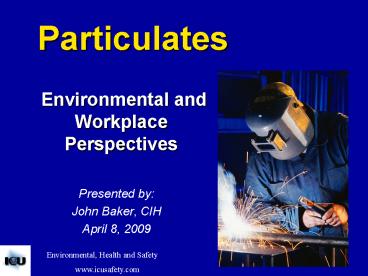John Baker, CIH - PowerPoint PPT Presentation
1 / 36
Title: John Baker, CIH
1
Environmental and Workplace Perspectives
Particulates
- Presented by
- John Baker, CIH
- April 8, 2009
2
Outline
- Environmental and Industrial Hygiene define and
assess particulates differently - Basis for compliance and corrective action
decisions - Emerging issues including ultrafine particulates
and nanoparticles
3
Global Particulate Pollution
http//veimages.gsfc.nasa.gov/1651/toms_indonesia_
smog_lrg.jpg
4
Workplace Particulate Exposure
http//www.hfinster.de/StahlArt2/archive-Integrate
dSteelworks-C-260-6-11.01.1993-en.html
5
Environmental - Industrial Hygiene
- Considers the very young, and elderly
- Health compromised
- 24/7 exposure
- Effects on property
- Haze and visibility
- Epidemiology
- Different scientific references than IH
- To protect most nearly every worker
- Medical surveillance
- Historically industrial
- More recently, office and residential
- Toxicology
- OSHA not cover all workplaces (MSHA, States)
6
Particulate Matter Pathology
Pope, C.A. and Dockery, D.W., JAWMA 56709-742
(2006)
7
Definitions
- Particulate
- Aerosol
- Dust
- Fiber
- Mists
- Fogs
- Fume
- Smoke
8
Combustible Dust
- Safety issue in addition to health
- Surface area
- Chemical nature
- Concentration
- Enclosed space
- Available oxygen
9
Sizing Considerations
- Retention on Surfaces
- Inertial Motion and Deposition
- Sedimentation
- Diffusion
- Aerodynamic Diameter
10
Environmental Sizing
- Total Particulate Matter up to 100 um
- Particulate Matter
- PM10 particles lt 10 um
- Fine PM
- PM2.5 particle lt 2.5 um
- Coarse PM
- PM10 PM 2.5
11
2006 NAAQS for PM species
12
2005 WHO Guidelines for PM
13
Environmental PM Samplers
14
Respiratory Deposition
15
ACGIH Criteria
- Inhalable
- Hazardous anywhere in respiratory tract
- 50 cut point at 100 um
- Thoracic
- Within lung airways and gas-exchange region
- 50 cut point at 10 um
- Respirable
- 50 cut point at 4 um
16
Nuisance Dust
- Particles (insoluble or poorly soluble) Not
Otherwise Specified PNOS - ACGIH warns against misuse of PNOS
- Guideline, not a TLV
- Inflammation or lung overload effects
- 3 mg/m3 respirable
- 10 mg/m3 inhalable
17
Total Dust Monitor
- NIOSH 0500
- Gravimetric
- 37mm PVC 5 um
- Preweighed Filter
- 0.03 mg/sample LOD
- 1 2 Lpm (7 133 L)
- Matched Weight
- MCE 0.8 um
18
Total Dust Monitor
19
Inhalable Dust Sampler
- SKC IOM Inhalable sampler
- 100 um
- 2 lpm
- Could be a high degree of error
20
Respirable Dust Samplers
- Left
- Dorr-Oliver 10 mm Nylon Cyclone
- Right
- SKC Aluminum Cyclone
21
Particle Counters
- Optical
- 6 bin sizes
- 0.2 - 0.3 um minimum
- Light scattering
- Condensation
- 0.02 1 um
- Not separated by size
- Alcohol or water droplets 5 -15 um
22
Timely Particle Issues
- OSHA National Emphasis Program for Crystalline
Silica - Ultrafine particles
- Engineered Nanoparticles
23
Remember
- The vague term particulate matter with no
designation of its chemical or physical nature
violates every principle of toxicology. - W.C.L. Hemeon, A critical review of regulations
for the control of particulate emissions, JAPCA
23 376-387 (1973)
24
Silica Update
- OSHA National Emphasis Program (NEP)
- January 24, 2008
- Builds upon the 1996 Special Emphasis Program
(SEP) - Construction and Maritime guidance on using OSHA
adopted conversion of - 0.1 mg/m3 per 1 mppcf
25
Respirable Silica Monitoring
- ACGIH/ISO/CEN curve (4 um cut off)
- 2.5 lpm for SKC Aluminum cyclone
- BMRC curve (5 um cut off)
- 1.9 lpm for SKC Aluminum cyclone
- OSHA must use former ACGIH curve (3.5 um cut off)
and nylon cyclone - 1.7 lpm
- PW 37 mm 5 um PVC filter XRF analysis
26
Standards and Guidelines
- OSHA 29 CFR 1910.1000 General Ind.
- PEL (10 mg/m3) / (2 resp. quartz)
- Cristobalite or Tridymite ½ Quartz PEL
- OSHA 29 CFR 1926.55(a) Construction
- PEL (250 mppcf) / (5 resp. quartz)
- Divide by 10 to convert to mg/m3
- ACGIH TLV
- a Quartz Cristobalite, 0.025 mg/m3 Resp.
- Tridymite withdrawn 2005, insufficient data
27
Piggy Back Toxic Chemicals
- Some environmental scientists have estimated that
50 to 75 of the toxic species are in the PM
2.5 fraction - 70 of PM 2.5 may reach alveoli and be taken into
the bloodstream with their toxic adsorbents - JAWMA, 45 680-681 (1995)
28
For Example
- Some PM 10 is considered to have a microsponge
structure - Some PM 1 is considered to have a snowflake or
fractal structure - These surface characteristics may act as
molecular sieves with huge and indeterminate
surface areas
29
Diesel Particulate Update
- MSHA
- 160 ug/m3 total carbon 8 TWA (May 20, 2008)
- Specialized cassette/filter/cyclone
- NYSDEC other State Env. Agencies
- Investigating ultra-fine diesel emissions
- Less than 100 nm particle size
30
Nanotechnology Definition
- ASTM E 2456 Terminology Standard
- 1 to 100 nm length scale
- Novel chemical and/physical properties emerge at
this length scale - Ability to control or manipulate on the atomic
scale
31
Engineered Nanoparticles
- Fullerenes
- Carbon Nanotubes
- Nanoshells
- Quantum Dots
32
Aggregates of Nanotubes
- Individual nanotubes have extremely short
lifetime in air - Agglomerate by Van der Waals or capillary forces
- Aggregate by fusing, sintered, metallically
bonded forces - May be hundreds of nm in smallest length scale
33
Guidance on Nanoparticles
- ASTM E 2535 07 Std Guide for Handling Unbound
Engd NPs in Occ. Settings - Approaches to Safe Nanotechnology An Information
Exchange with NIOSH - www.cdc.gov/niosh/topics/nanotech/safenano
- EPA Fact Sheet for Nanotech under TSCA
- http//www.epa.gov/oppt/nano/nano-facts.htm
- ICON at Rice University
- http//icon.rice.edu
34
Respiratory Protection
35
Protective Clothing
36
Summary
- Environmental and Industrial Hygiene may
classify particles differently. - Size matters, but so do chemical and other
considerations. - What information do you need for the decision you
must make? - Sample accordingly.































